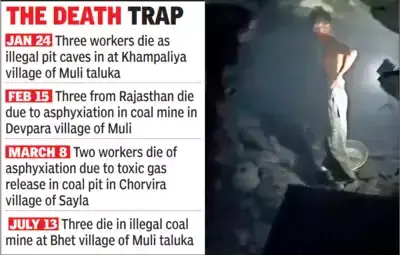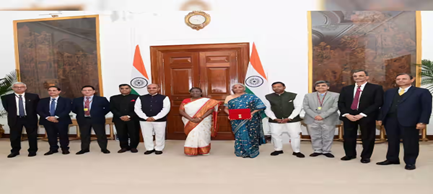Tuesday, 30th July 2024
Ethanol Used In Petrol Now More From Maize,
Why in the news?
- During the current supply year (November 2023 to October 2024), sugar mills and distilleries have supplied 401 crore litres of ethanol to oil marketing companies up to June 30.
- Notably, 211 crore litres (52.7%) of this ethanol were produced from maize and damaged food grains, primarily broken or old rice unsuitable for human consumption.
- The remaining 190 crore litres were derived from sugarcane-based feedstocks, including molasses and whole juice/syrup.
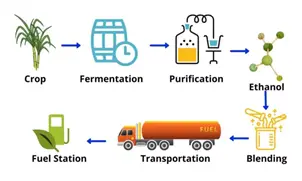
About the Biofuel:
- Definition:
- Biofuel is a fuel produced from biomass over a short time span, unlike fossil fuels which form through very slow natural processes.
- Biomass can be used directly as fuel (e.g., wood logs), leading some to use the terms biomass and biofuel interchangeably.
- However, biofuel usually refers to liquid or gaseous fuels used for transportation.
- Consumption:
- Most biofuel consumption occurs as a blend with refined petroleum products such as gasoline, diesel fuel, heating oil, and kerosene-type jet fuel.
- Some biofuels, known as drop-in biofuels, do not require blending with petroleum counterparts.
- Types of Biofuels:
- Bioalcohols: Ethanol, propanol, and butanol (substitutes for petrol/gasoline).
- Biodiesel: A substitute for diesel.
- Bio-oils: Substitutes for kerosene.
Generations of Biofuel:
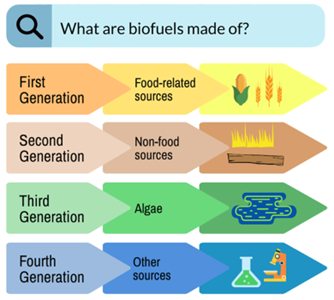
What is the Ethanol Blending?
- Definition:
- Ethanol is a biofuel naturally produced by the fermentation of sugars by yeasts or by petrochemical processes like ethylene hydration.
- Ethanol’s high oxygen content allows for more thorough combustion of fuel in engines.
- Blending Process:
- Ethanol blending involves mixing ethyl alcohol derived from agricultural products with petrol.
- Production in India:
- The Department of Food and Public Distribution (DFPD) is the nodal department promoting fuel-grade ethanol-producing distilleries.
- Ethanol is produced or procured from sugarcane-based raw materials like C & B heavy molasses, sugarcane juice, sugar syrup, surplus rice with Food Corporation of India (FCI), and maize.
- Global Production:
- In 2019, over 110 billion liters of ethanol fuel were produced globally.
- The US and Brazil account for 84% of global production, followed by the European Union, China, India, Canada, and Thailand.
- Benefits of Ethanol Blending:
- Reduces dependency on petroleum imports, with India importing over 85% of its oil requirements.
- In 2020-21, India’s net import of petroleum was 185 million tonnes at USD 551 billion.
- Ethanol blending can save billions of dollars and reduce import dependency.
- Ethanol is less polluting and more cost-effective than petrol.
India’s Biofuel Policy:
The Central government amended the Biofuel Policy (2018) to set a target of 20% ethanol and 5% biodiesel blending by 2025.
According to NITI Aayog’s Roadmap for ethanol blending in India 2020-2025 report, India needs to increase ethanol production capacity from the expected 3.3 billion liters (in 2020–2021) to at least 10.2 billion litres by 2025.
Recent Developments in Ethanol Production:
- Shift to Maize and Damaged Foodgrains:
- During the current supply year (November 2023 to October 2024), sugar mills and distilleries supplied 401 crore litres of ethanol to oil marketing companies up to June 30.
- Of this total, 211 crore litres (52.7%) were produced using maize and damaged foodgrains (primarily broken or old rice unsuitable for human consumption).
- The remaining 190 crore litres were derived from sugarcane-based feedstocks, including molasses and whole juice/syrup.
- This marks the first time that the contribution of grains to India’s ethanol production has surpassed 50%—up from 27.1% in 2022-23, 16.7% in 2021-22, 13.6% in 2020-21, 9.2% in 2019-20, 5% in 2018-19, and zero in 2017-18.
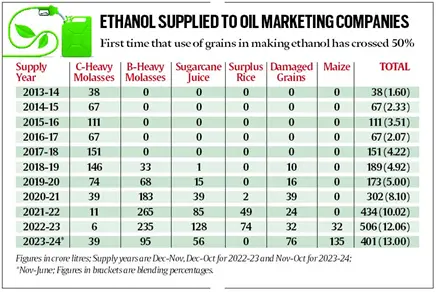
- Reasons for the Shift:
- Until 2017-18, ethanol production in India was limited to C-heavy molasses, a byproduct of the sugar industry.
- The Ethanol Blended Petrol (EBP) program expanded in 2018-19, allowing production from B-heavy molasses and whole cane juice/syrup, with mills receiving higher prices to offset reduced sugar production.
- The program further diversified with the use of surplus and damaged rice from the Food Corporation of India (FCI).
- From July 2023, the government stopped supplying FCI rice and restricted the use of cane juice and B-heavy molasses due to concerns over cereal and sugar inflation.
- Consequently, maize has become the primary ethanol feedstock, incentivized by a higher ex-distillery price of Rs 71.86 per litre.
- The EBP program now uses multiple feedstocks to meet ethanol demand, benefiting maize farmers in states like Karnataka and Bihar.
- However, poultry and livestock feed industries report a domestic maize shortage, with production at 36 million tonnes against a requirement of 41 million tonnes.
- The government has allowed 0.5 million tonnes of maize imports at a 15% concessional duty, but the industry seeks up to 5 million tonnes of imports at zero duty.
|
UPSC Civil Services Examination, Previous Year Question (PYQ) Prelims: Q:1 According to India’s National Policy on Biofuels, which of the following can be used as raw materials for the production of biofuels? (2020)
Select the correct answer using the code given below:
Ans: (a)
Q:2 Given below are the names of four energy crops. Which one of them can be cultivated for ethanol? (2010)
Ans: (b) |
Source: IE
CITES eases export of agarwood from India
Why in the news?
- India has successfully prevented the inclusion of Aquilaria malaccensis (agarwood) in the Review of Significant Trade (RST) of the Convention on International Trade in Endangered Species of Wild Fauna and Flora (CITES).
- Additionally, CITES has announced a new export quota for the highly valuable and aromatic resinous wood and oil of agarwood from India, effective April 2024.
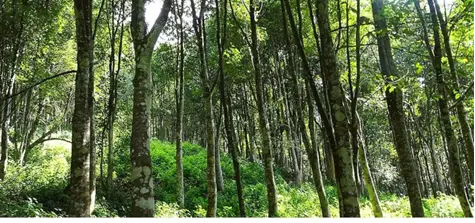
Convention on International Trade in Endangered Species of Wild Fauna and Flora (CITES):
- About:
- CITES is an international agreement aimed at ensuring that international trade in wild animals and plants does not threaten their survival.
- It regulates and monitors the trade of endangered species to prevent their exploitation and ensure their long-term survival in the wild.
- Signed in 1973 by 184 parties, it entered into force in 1975.
- While legally binding, CITES does not replace national laws but provides a framework for international cooperation to promote sustainability and regulate trade.
- Structure:
- The CITES Secretariat, administered by UNEP (United Nations Environment Programme) and located in Geneva, Switzerland, manages the convention.
- The Conference of the Parties (CoP) is the supreme decision-making body of CITES.
- Three Categories or Appendices:
- Appendix I: Species threatened with extinction; trade is permitted only in exceptional circumstances.
- Appendix II: Species not necessarily threatened with extinction but requiring trade controls to avoid exploitation that could threaten their survival.
- Appendix III: Species protected in at least one country, which has requested assistance from other CITES Parties to control trade.
- Species can be added to or removed from Appendices I and II only by the CoP. Species can be added to or removed from Appendix III unilaterally by any Party.
Review of Significant Trade (RST) of CITES:
- About RST:
- RST is a process under CITES designed to ensure that trade in certain species is sustainable and does not threaten their survival.
- Species are reviewed based on trade data, reports from member countries, or concerns raised by CITES scientific committees.
- The status of these species is assessed to determine trade sustainability and compliance with CITES requirements.
- Recommendations may include setting export quotas, improving legislation, or enhancing enforcement.
Agarwood:
- About:
- Aquilaria malaccensis, known as agarwood, is a tree species in the Thymelaeaceae family, valued for its fragrant resinous wood.
- The resin forms in response to mould infection and is known as agarwood, oud, or aloeswood.
- Uses:
- Perfumes and Incense: Highly prized for its unique, long-lasting fragrance.
- Traditional Medicine: Used in Ayurveda and Traditional Chinese Medicine for its potential health benefits.
- Spiritual Practices: Utilised in rituals and meditation for its calming effects.
- Conservation Status:
- Listed in Appendix II of CITES since 1995 to regulate trade and prevent exploitation that could threaten its survival.
CITES Eases Export of Agarwood from India:
- Inclusion of Agarwood in RST Prevented:
- India has successfully prevented agarwood from being included in the RST of CITES.
- This decision benefits farmers in Assam, Manipur, Nagaland, and Tripura.
- Decision Based on Study by BSI:
- The Botanical Survey of India (BSI), under the Ministry of Environment, Forest and Climate Change (MoEFCC), conducted a study (non-detriment finding, NDF) concluding that agarwood can be sustainably harvested under certain conditions.
- Key Points from the NDF:
- Restrictions: Harvesting should not occur from wild populations, protected areas, or reserve forests.
- Permitted Harvesting: Allowed from home gardens, plantations on leased or patta lands, private/community plantations, and other regulated sources.
- Export Quotas: Recommended an export quota for 2024–2027 of 151,080 kg per year of agarwood chips and powder/sawdust, and 7,050 kg per year of agarwood oil.
- Issues with Agarwood Trade:
- Informal Trade Increase: Long-term absence of an export quota and trade restrictions led to increased informal trade.
- Global Market Impact: Rise in costs of agarwood chips and oil due to restricted legal trade.
- Legal Restrictions: Previous quotas and legal restrictions pushed growers towards informal trading.
Source: TH
Government Proposes Including Class 9-11 Performance
Why in the news
- A recent report by PARAKH (Performance Assessment, Review, and Analysis of Knowledge for Holistic Development) recommends that the performance of students in Classes 9, 10, and 11 should be considered in their final marks at the end of Class 12.
- This recommendation is aligned with the National Education Policy (NEP) and aims to standardise assessment practices, develop capacity, conduct achievement surveys, and establish equivalence among different school boards.
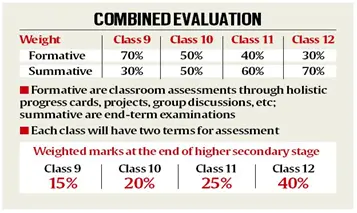
What is PARAKH ?
- About:
- PARAKH, established as the National Assessment Centre in NCERT in 2023, operates as an independent body.
- The team consists of leading assessment experts with extensive knowledge of the Indian and international education systems.
- PARAKH is set to become the national single-window source for all assessment-related information and expertise, supporting learning assessments both nationally and globally.
- Objective:
- PARAKH aims to set norms, standards, and guidelines for student assessment and implement activities as mandated by the NEP 2020.
Four Major Areas of Focus:
- Capacity Development in Competency-Based Assessment:
- Project Vidyasagar: PARAKH organises workshops across India to introduce educators to the new pedagogical and policy changes in the National Curriculum Framework 2023,
- The goal is bridging gaps in implementing competency-based learning and teaching.
- Large-Scale Achievement Survey:
- In November 2023, PARAKH conducted the State Educational Achievement Survey, assessing students in Grades 3, 6, and 9 across 30 States/UTs.
- The survey monitors educational competencies in literacy, numeracy, language, and mathematics.
- Equivalence of School Boards:
- PARAKH is working to standardise examination reforms across all Indian school boards.
- Data collection through regional workshops and national workshops aims to draft policy recommendations for equivalence, including allocating credit points to academic, vocational, and experiential learning.
- Holistic Progress Cards:
- The Holistic Progress Card (HPC) will shift from traditional marks or grades to a 360-degree evaluation.
- This model emphasises continuous assessment through class activities where students demonstrate their understanding and skills.
Significance:
- Uniformity: PARAKH addresses disparities in scores among students from different boards, aiding fair college admissions.
- Standardisation: It establishes and implements technical standards for test design, administration, and reporting.
- Skill Development: Encourages school boards to align assessments with 21st-century skill requirements.
Recommendations by PARAKH:
- Inclusion of Performance from Classes 9-11:
- It is proposed that performance from Classes 9, 10, and 11 be included in the Class 12 report card, with a weight of 15% for Class 9, 20% for Class 10, 25% for Class 11, and 40% for Class 12.
- Evaluation Method:
- Evaluations should combine formative assessments (continuous classroom assessments) and summative assessments (term-end examinations):
- Class 9: 70% formative and 30% summative.
- Class 10: 50% formative and 50% summative.
- Class 11: 40% formative and 60% summative.
- Class 12: 30% formative and 70% summative.
- Evaluations should combine formative assessments (continuous classroom assessments) and summative assessments (term-end examinations):
- Credit System:
- Assessments should be quantified in credits: 40 credits each for Classes 9 and 10, and 44 credits each for Classes 11 and 12.
- Classes 9 and 10: 32 credits will be subject-specific (12 credits in languages; 4 credits in mathematics; 4 credits in science; 4 credits in social science, etc.).
- Facilitate Credit Transfer:
- Boards should develop a credit transfer system in line with the National Credit Framework.
Source: IE
NIPUN Bharat Mission
Why in the news?
- The new National Education Policy (NEP 2020) was launched on 29 July, four years ago and there are a set of interlinked social and demographic trends which, if leveraged, could provide a boost to the NIPUN Bharat Mission.

About NIPUN Bharat Mission:
- Mission Overview
- Full Name: National Initiative for Proficiency in Reading with Understanding and Numeracy (NIPUN Bharat).
- Launch: Initiated by the Ministry of Education, Government of India.
- Target Group
- Age Range: Focuses on children aged 3 to 9 years.
- Education Levels: Covers preschool to Grade 3.
- Implementation Mechanism
- Five-Tier Structure: Implemented at National, State, District, Block, and School levels.
- Scope: Applicable across all States and Union Territories (UTs).
- Association with Samagra Shiksha
- Centrally Sponsored Scheme: Operates under the Samagra Shiksha scheme.
- Universal Goals: Aims for universal acquisition of Foundational Literacy and Numeracy (FLN) skills by 2026-27.
- Inclusive Approach
- Schools Involved: Applies to Government, Government-Aided, and Private Schools.
- State Situation:
- In states like Uttarakhand, Maharashtra, Punjab, and Haryana, 30-40% of mothers of young children have had schooling beyond Grade 10.
- In Tamil Nadu, this figure is close to 43%, while in Himachal, it is higher than 54%.
- Kerala tops this list with almost 72% of these mothers receiving high school education.
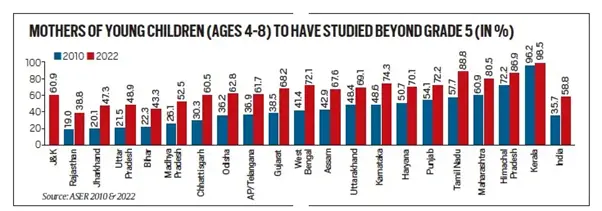
Objectives and Focus Areas:
- Access and Retention
- Ensure children are enrolled and retained in foundational years of schooling.
- Teacher Capacity Building
- Enhance the skills and competencies of teachers.
- Development of Resources
- Create high-quality and diverse learning materials for students and teachers.
- Progress Tracking
- Monitor each child’s progress in achieving learning outcomes.
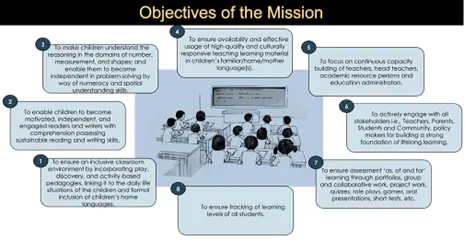
Contextual Background:
- NEP 2020
- Launch: Four years ago, introducing significant reforms in the Indian education system.
- Leverage Trends: The NEP 2020 aligns with social and demographic trends to support initiatives like NIPUN Bharat.
- Foundational Literacy and Numeracy (FLN)
- Core Focus: Strengthening the foundational skills in reading, understanding, and numeracy for young learners.
- Holistic Education Approach
- Inclusive Education: Ensures all children, regardless of their socio-economic background, achieve foundational literacy and numeracy.
Goals and Impact:
- Universal Acquisition
- By 2026-27: Aim to ensure all children acquire necessary FLN skills within the set timeframe.
- Quality Education
- Outcome-Based: Focuses on measurable learning outcomes and progress tracking.
- Capacity Building
- Teacher Empowerment: Equip teachers with the necessary skills and resources to facilitate effective learning.
Source: IE
The State of Food Security and Nutrition in the World 2024
Why in the news?
- The "State of Food Security and Nutrition in the World 2024" (SOFI 2024) report, published by FAO, IFAD, UNICEF, WFP, and WHO, provides a critical analysis of global food security and nutrition trends.
- The report emphasises the urgent need for increased financing to tackle hunger, food insecurity, and malnutrition in all its forms.

Key Findings of the SOFI 2024 Report
- Global Prevalence of Undernourishment:
- 713 to 757 million people faced hunger in 2023.
- One out of eleven people globally and one out of five in Africa faced hunger.
- Asia, despite a lower percentage, has the largest number of undernourished people (384.5 million).
- Food Insecurity:
- 2.33 billion people experienced moderate or severe food insecurity in 2023.
- 864 million people experienced severe food insecurity globally.
- Cost of a Healthy Diet:
- The global average cost of a healthy diet rose to USD 3.96 per person per day in 2022.
- Despite the increase, 2.83 billion people were unable to afford a healthy diet in 2022.
- Regional disparities exist, with Latin America and the Caribbean having the highest costs, and Oceania the lowest. Recovery in affordability has been uneven, particularly in Africa.
- Stunting and Wasting:
- Improvements have been made in reducing stunting and wasting among children under five.
- Progress remains insufficient to meet the 2030 SDG targets.
- The rate of exclusive breastfeeding among infants under six months has increased but still falls short of the 2030 target.
- Obesity and Anaemia:
- Global obesity rates are rising.
- Anaemia in women aged 15 to 49 years is increasing, posing significant public health challenges.
- Current Levels and Gaps:
- Public spending on food security and nutrition remains inadequate, particularly in low-income countries.
- Tracking private financing flows is challenging, exacerbating the funding gap.
Key Highlights Related to India:
- Undernourishment:
- India is home to 194.6 million undernourished individuals, the highest globally.
- The number of undernourished people has decreased from 240 million in the 2004-06 period.
- Cost of a Healthy Diet:
- 55.6% of Indians, or 790 million people, cannot afford a healthy diet, an improvement of about 3 percentage points from 2022.
- Chronic Undernourishment:
- 13% of India's population suffers from chronic undernourishment.
- Global Hunger Index (GHI) 2023:
- India ranked 111th, reflecting significant issues in food security.
- Nutritional Status:
- India has the highest prevalence of wasting (18.7%) and a high prevalence of stunting (31.7%) in children under five in South Asia.
- 27.4% of babies born in India have low birth weight, the highest globally.
- 53% of women in India are anaemic, the highest in South Asia.
- Obesity and Physical Inactivity:
- Obesity prevalence in children under five is 2.8%, and in adults, it has risen to 7.3%.
- A significant portion of the Indian population is physically inactive, contributing to rising obesity rates.
- Diet Quality and Ultra-Processed Foods:
- Both undernutrition and obesity co-exist, driven by poor diet quality.
- Consumption of ultra-processed foods is linked to adverse health outcomes, with many food products by top global manufacturers in India deemed unhealthy by WHO standards.
- Public Spending and Covid-19 Impact:
- India's public spending on food security and nutrition has increased but still requires more effective allocation and utilisation.
- The Covid-19 pandemic has exacerbated food insecurity and malnutrition issues due to economic downturns, loss of livelihoods, and disruptions in food supply chains.
Key Recommendations in the SOFI 2024 Report:
- Increase Public Investment:
- Boost Budgets: Increase public spending on food security and nutrition programs.
- Local Community Involvement: Engage local communities in planning and implementing programs to improve effectiveness and sustainability.
- Mobilise Private Sector Investment:
- Innovative Financing: Encourage private sector investment through mechanisms such as social bonds, green bonds, and sustainability-linked bonds.
- Partnerships: Strengthen global partnerships and align national policies with international frameworks to enhance the exchange of knowledge, technology, and resources.
- Promote Climate-Resilient Agriculture:
- Develop Practices: Invest in the development and implementation of climate-resilient agricultural practices.
- Research and Development: Focus on research and development of drought-resistant crops and sustainable farming practices to mitigate climate change impacts.
- Improve Agrifood Systems:
- Enhance Efficiency: Improve the efficiency and sustainability of agrifood systems.
- Infrastructure and Market Access: Invest in better infrastructure, logistics, and market access to reduce food loss and waste.
- Comprehensive Nutrition Programs:
- Integrated Approach: Develop and implement integrated nutrition programs addressing both undernutrition and overnutrition.
- Balanced Diets and Physical Activity: Promote balanced diets and physical activity to combat rising obesity rates.
- Focus on Vulnerable Populations:
- Support Vulnerable Groups: Implement policies supporting vulnerable groups, including small farmers, women, and children.
- Nutrition for Pregnant Women and Children: Improve nutrition for pregnant women and young children through initiatives like exclusive breastfeeding and providing essential vitamins and minerals.
- Strengthen Data Collection, Monitoring, and Reporting:
- Enhance Data Collection: Improve data collection and integration with national databases.
- Policy Making: Use better data for tracking food security and nutrition to enable informed policymaking and identify areas for improvement.
|
UPSC Civil Services Examination, Previous Year Question (PYQ) Prelims: Q:1 Which of the following is/are the indicators/indicators used by IFPRI to compute the Global Hunger Index Report? (2016)
Select the correct answer using the code given below:
Ans: (c)
Q:2 How do District Rural Development Agencies(DRDAs) help in the reduction of rural poverty in India? (2012)
Which of the statements given above is/are correct?
Ans: (b)
Mains: Q:1 Can the vicious cycle of gender inequality, poverty and malnutrition be broken through microfinancing of women SHGs? Explain with examples. (2021) Q:2 Despite Consistent experience of high growth, India still goes with the lowest indicators of human development. Examine the issues that make balanced and inclusive development elusive. (2019) |
INS Tabar
Why in the news?
- Recently, The Russian President greeted Indian Navy personnel onboard Indian Naval Ship (INS) Tabar, which is participating in Russia’s Navy Day celebrations.

Key facts about the INS Tabar:
- About
- INS Tabar is a stealth frigate of the Indian Navy, built in Russia.
- It is the third of the Talwar-class frigates and was commissioned on April 19, 2004, in Kaliningrad, Russia.
- Operational Capabilities:
- Missions: Capable of handling air, surface, and subsurface missions, INS Tabar can operate independently on maritime missions or support a larger naval task force.
- Command: It is part of the Indian Navy’s Western Fleet, based in Mumbai under the Western Naval Command.
- Specifications:
- Displacement: 4,035 tons when fully loaded.
- Speed: Can achieve speeds of up to 30 knots (56 km/h; 35 mph).
- Range:
- 4,850 nautical miles (8,980 km; 5,580 mi) at a cruising speed of 14 knots (26 km/h; 16 mph).
- 1,600 nautical miles (3,000 km; 1,800 mi) at a maximum speed of 30 knots (56 km/h; 35 mph).
Armament and Equipment:
- Weapons:
- Supersonic BrahMos Missiles: INS Tabar is the first vessel in the Talwar class to be armed with these anti-ship cruise missiles.
- Barak-1 Missiles: Provides defence against aerial threats.
- Sensors and Systems: Equipped with a versatile range of weapons and sensors, enhancing its operational effectiveness.
- Recent Activity:
- On July 29, 2024, the Russian President greeted Indian Navy personnel onboard INS Tabar, which is participating in Russia’s Navy Day celebrations.
- INS Tabar exemplifies the growing collaboration between India and Russia, showcasing India's naval strength and the strategic importance of its maritime capabilities
Source: TP
Pollution Under Control (PUC) Certificate
Why in the news ?
- Recently, the Supreme Court abolished its own directive issued in 2017 that made a valid pollution under control (PUC) certificate mandatory for renewal of third-party insurance policy.

About Pollution Under Control (PUC) Certificate:
- About:
- The Pollution Under Control (PUC) Certificate, commonly known as the pollution certificate, is a mandatory document for every vehicle owner in India.
- It certifies that a vehicle's emissions are within the permissible levels set by the government, allowing the vehicle to be legally operated on Indian roads.
- Legal Framework:
- Requirement: All vehicles on Indian roads must possess a valid PUC certificate under the Central Motor Vehicles Rule, 1989.
- Validity:
- Generally, a new vehicle is exempt from needing a PUC certificate for the first year.
- After that, vehicles must undergo mandatory PUC tests at regular intervals to obtain a validity certificate.
- Duration: A PUC certificate is usually valid for a year from the date of issue.
- Penalties for Non-Compliance:
- Fines and Imprisonment: Failure to produce a valid PUC certificate can result in a fine of up to Rs 10,000, six months of imprisonment, or both under the Motor Vehicles Act.
- Licence Disqualification: The vehicle owner may also be disqualified from holding their licence for three months.
- Certificate Cancellation:
- If a vehicle is found to emit fumes beyond the prescribed limit despite possessing a valid PUC certificate, the certificate will be cancelled.
- The vehicle owner must obtain a new PUC certificate within seven days.
- Applicability:
- The PUC certificate requirement applies to all types of vehicles, including those powered by CNG, petrol, and diesel.
How to Obtain a PUC Certificate:
- Testing Centres: A PUC certificate can be obtained from a government-authorised emission test centre with a computerised facility.
- Examination: The issuance of a PUC certificate involves a thorough examination of the vehicle’s exhaust gas.
- Results: The test results are recorded in the PUC certificate, ensuring the vehicle's emissions are within the permissible limits.
Recent Development:
- On July 29, 2024, the Supreme Court abolished its own directive issued in 2017 that made a valid PUC certificate mandatory for the renewal of third-party insurance policies.
- This change impacts the integration of environmental compliance with insurance processes but does not affect the mandatory nature of the PUC certificate itself.
Source: HT
Share the article
Edukemy’s Current Affairs Quiz is published with multiple choice questions for UPSC exams
MCQ
Get Latest Updates on Offers, Event dates, and free Mentorship sessions.

Get in touch with our Expert Academic Counsellors 👋
FAQs
UPSC Daily Current Affairs focuses on learning current events on a daily basis. An aspirant needs to study regular and updated information about current events, news, and relevant topics that are important for UPSC aspirants. It covers national and international affairs, government policies, socio-economic issues, science and technology advancements, and more.
UPSC Daily Current Affairs provides aspirants with a concise and comprehensive overview of the latest happenings and developments across various fields. It helps aspirants stay updated with current affairs and provides them with valuable insights and analysis, which are essential for answering questions in the UPSC examinations. It enhances their knowledge, analytical skills, and ability to connect current affairs with the UPSC syllabus.
UPSC Daily Current Affairs covers a wide range of topics, including politics, economics, science and technology, environment, social issues, governance, international relations, and more. It offers news summaries, in-depth analyses, editorials, opinion pieces, and relevant study materials. It also provides practice questions and quizzes to help aspirants test their understanding of current affairs.
Edukemy's UPSC Daily Current Affairs can be accessed through:
- UPSC Daily Current Affairs can be accessed through Current Affairs tab at the top of the Main Page of Edukemy.
- Edukemy Mobile app: The Daily Current Affairs can also be access through Edukemy Mobile App.
- Social media: Follow Edukemy’s official social media accounts or pages that provide UPSC Daily Current Affairs updates, including Facebook, Twitter, or Telegram channels.


